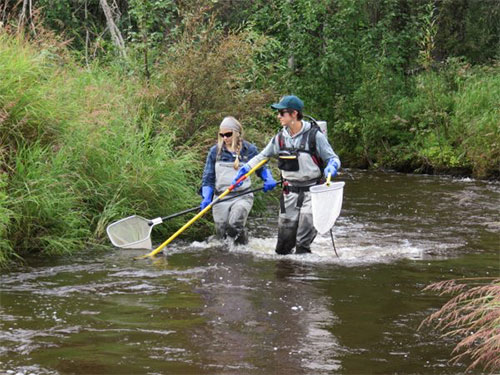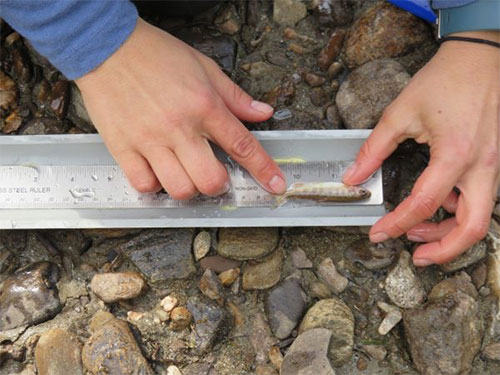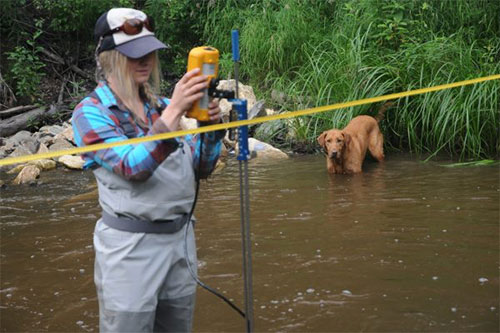
Researchers study how wildfires affect fish habitatsBy LAUREN FRISCH
February 13, 2019
Wildfires are one of the main forms of natural disturbance to Alaska’s boreal forests. Over the past few decades, climate change has increased the frequency, severity and extent of wildfires in Interior Alaska. A research team from the UAF College of Fisheries and Ocean Sciences, led by Jeff Falke, wants to know what this means for the ability of ecosystems to recover from a wildfire.
“Here in Interior Alaska, where human impacts are relatively low compared to the rest of the United States, we have a great opportunity to study how natural fire processes impact streams, habitats and fish,” Falke said. In particular, Falke’s team wants to understand how increases in wildfire severity may impact boreal watersheds, which are important habitats for juvenile salmon in Alaska. Wildfires can have positive and negative impacts on ecosystems. Periodic wildfires can be positive for an ecosystem by helping to maintain habitats. For example, by increasing woody debris flow into streams, fires can improve habitats for juvenile fish that often live in logjams. But high-intensity fires may have more lasting impacts by wiping out more of the ecosystem, and these fires are becoming more common as ecosystems change. Understanding the impact fires have on different aspects of the ecosystem, and how different species recover from a fire, will help managers prioritize areas where fire suppression and habitat restoration may be needed. Falke’s team will collect aquatic ecosystem samples in boreal watersheds for three years. These samples will provide the baseline data for an ecosystem model that will help predict how future wildfires will impact streams in Interior Alaska. With funding from the Department of Defense Strategic Environmental Research and Development Program, researchers will study a number of ecosystem components that will contribute to the model.
CFOS Ph.D. student Elizabeth Hinkle is collecting data on fish health, diet and reproductive status. Her team chose to focus on Arctic grayling because they are abundant and can be found everywhere. This makes grayling an easy species to collect and compare between regions. Hinkle will collect samples in watersheds according to the length of time since a fire last occurred. About one-third of these samples will be taken at locations that have experienced a fire in the last 10 to 15 years. Historic site samples will be taken in regions that experienced a fire in the last 20 to 50 years. And finally, control samples will be taken at sites that haven’t experienced a fire in more than 50 years, based on the assumption that an ecosystem would be able to recover in this amount of time. Hinkle will record a variety of information on each fish they are able to collect. “We’ll measure the fish and record their size,” Hinkle said. “Then we’ll extract gut samples and see what they are eating. We can also assess lipid content, which gauges how healthy they are, by putting two little electrodes along their bodies and sending an electric pulse through the electrodes.” In general, the bigger and more plump fish are, the healthier. Hinkle’s team is also working to determine how healthy fish are when they start producing eggs. If grayling are big and plump when they begin producing eggs, this suggests the population is doing well. If small, skinny fish are producing eggs, it could suggest the population is strained for resources. Together, these variables will provide important insight on the health of grayling populations at the three different study sites.
UAF Institute of Arctic Biology researcher Deanna Klobucar is studying how temperature and stream flow are affected by wildfires. When fire removes vegetation from the landscape, Klobucar said, “this increases sunlight on streams, and subsequently increases water temperatures. Additionally, removing vegetation increases runoff into the water, which can increase flow rates and erode riverbanks.” Klobucar explained that it’s easiest for a fish to live in a stream where flow rates aren’t super fast, because it takes less energy to forage and live there. The effects of changes in flow rates after a wildfire are part of what the research team wants to explore. Changes in water temperature may have different kinds of impacts because temperature often provides important cues for fish. For example, decreasing water temperatures cue fish that it’s time to move out of a tributary for the winter. Fluctuating temperature ranges after a wildfire could disrupt these cues and have important implications for basic life functions of the fish living in these water bodies. On the flip side, cold water may limit the populations of some fish in Interior Alaska streams. If this is the case, increasing temperatures may actually allow fish populations to increase. The researchers hope their model will be able to help them piece together these sorts of important ecosystem linkages. Wildfires influence many interconnected variables in the ecosystem, and all of these changes can impact grayling, salmon and other fish living in boreal streams and rivers. This work is a first step in understanding those links so future managers can make sure they are responding to wildfires appropriately. “If we can better understand how warming climate is likely to affect freshwater systems, then we can mitigate some of the consequences by altering the ways we interact with land and waterways,” Hinkle said. “This may help us alleviate some of the pressures on freshwater systems and the important resources that all Alaskans rely on.”
|
|||||||


